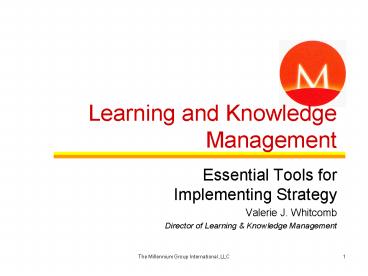Learning and Knowledge Management - PowerPoint PPT Presentation
1 / 19
Title:
Learning and Knowledge Management
Description:
Learning and Knowledge Management Essential Tools for Implementing Strategy Valerie J. Whitcomb Director of Learning & Knowledge Management * – PowerPoint PPT presentation
Number of Views:533
Avg rating:3.0/5.0
Title: Learning and Knowledge Management
1
Learning and Knowledge Management
- Essential Tools for Implementing Strategy
- Valerie J. Whitcomb
- Director of Learning Knowledge Management
2
Overview
- Just as learning opportunities contribute to a
successful society, so do they add to a
successful enterprise. - Learning is knowledge transfer and this is the
key to a sustainable competitive advantage in
todays rapidly changing economic climate.
3
Organizational Assessment
- If you have no idea where you want to go any
road will take you there. - On the other hand, if you have a destination, a
roadmap (or GPS) is a handy tool. Compare
current to future knowledge requirements and
develop your workforce to specifications.
4
Assessment Considerations
- There are several things to keep in mind when
formulating a learning and knowledge strategy - What must be learned
- How learning takes place
- Areas of specialization
- The extended enterprise
5
1. Learning Components
- Your human capital will have to implement the
chosen strategy. The essential forms of training
that will produce the right organizational
knowledge are - Procedures and Policy
- Skills
- Compliance and Regulations
- Human Development
- Cross Training
6
Groups of Learners
Procedures Skills Compliance Developmental Cross
Training
7
Where Learning Occurs
- Consider the following types of learning in
assessing strategies - On the job
- In a classroom
- Skills
- Online course delivery
- Seminars
- Blended learning programs
- Tacit transfer of knowledge
8
Groups of Learners
Procedures Skills Compliance Developmental Cross
Training
On the Job Online Classroom Skills
Practice Seminars
9
Unique Knowledge Requirements
- We can group learners in many useful ways
- Departments
- Client teams
- Subject matter experts
- Divisions
- Countries
- Job category
- Job description
- Number of reports
- Etc..
10
Groups of Learners
Procedures Skills Compliance Developmental Cross
Training
On the Job Online Classroom Skills
Practice Seminars
Departments Divisions Countries Job
Categories Job Descriptions
11
The Enterprise
- When we extend learning requirements to all the
stakeholders - Employees
- Customers
- Suppliers
- Distributors
- Members
- Other stakeholders
12
Groups of Learners
Procedures Skills Compliance Developmental Cross
Training
On the Job Online Classroom Skills
Practice Seminars
Employees Suppliers Distributors Customers Partner
s
Departments Divisions Countries Job
Categories Job Descriptions
13
Social Networks
14
Performance Standards
- Employees cannot be held accountable to
performance standards unless there is a
demonstration of knowledge. - The right knowledge in the right minds at the
right time is required to - Function properly
- Move to the next level
- Implement your strategy
15
Managing Groups of Learners
- If every individual must contribute to the
mission of the organization, how will this
process be managed? Learners should be grouped
into categories. for instance - Everyone in a given department should know the
procedures - Each job function has a set of skills required to
do the job properly - All managers should have supervisory training
- Compliance and orientation is required for all
employees
16
Functions of a Learning System
- Tracking learning outcomes
- Activity administration
- Grouping like learners
- Learning deployment
- Knowledge management
- Creating knowledge objects
- Repository functions
- Updating and delivering
- Reporting
17
(No Transcript)
18
Establishing a Program
- Needs Assessment
- Gap analysis and roadmap
- Learning system
- Internal buy-in at all levels
- ROI in human capital
- Performance metrics
- Continuous process improvement
- Managing continuous change
19
Building a Learning Organization
- The system has many components that must work
together - Once the organization learns to learn it
becomes capable of spontaneous change - Transformational learning can happen at any or
all levels of an organization - This is the essence of a change-centric
organization































